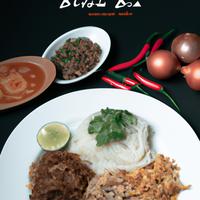
1 serving (100 grams) contains 364 calories, 7.0 grams of protein, 0.5 grams of fat, and 80.0 grams of carbohydrates.

Log this food in SnapCalorie

Nutrition Information
Calories |
728 | ||
|---|---|---|---|
% Daily Value* |
|||
| Total Fat | 1 g | 1% | |
| Saturated Fat | 0.2 g | 1% | |
| Polyunsaturated Fat | 0 g | ||
| Cholesterol | 0 mg | 0% | |
| Sodium | 20 mg | 0% | |
| Total Carbohydrates | 160 g | 58% | |
| Dietary Fiber | 2 g | 7% | |
| Sugars | 0 g | ||
| protein | 14 g | 28% | |
| Vitamin D | 0 mcg | 0% | |
| Calcium | 20 mg | 1% | |
| Iron | 3 mg | 16% | |
| Potassium | 40 mg | 0% | |
* Percent Daily Values are based on a 2,000 calorie diet. Your daily values may be higher or lower depending on your calorie needs.
Food Attributes
Source of Calories
About Bihun
Bihun, also known as rice vermicelli, is a type of thin rice noodle popular in Southeast Asian cuisine, particularly in Indonesia, Malaysia, Thailand, and Vietnam. Made from rice flour and water, bihun is naturally gluten-free and low in fat, making it a suitable option for people with specific dietary restrictions. It’s commonly used in stir-fries, soups, or salads, often paired with vegetables, lean proteins, and flavorful spices. While bihun is a good source of carbohydrates, it lacks significant amounts of protein, fiber, or vitamins, so its nutritional value largely depends on the ingredients it’s cooked with. When prepared in healthy dishes, bihun can be part of a balanced diet, but deep-fried versions or recipes with excessive sodium can reduce its healthiness. Versatile and easy to digest, bihun is a staple that complements a variety of wholesome ingredients.



